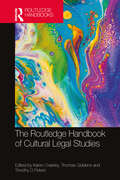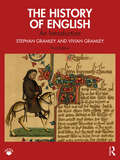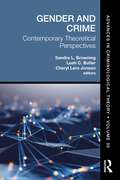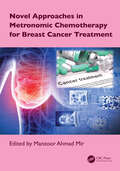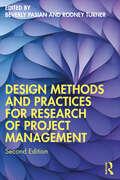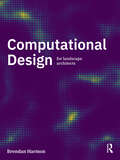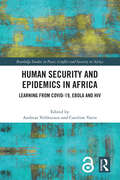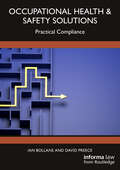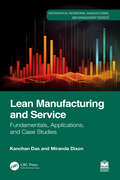- Table View
- List View
Manual of Definitive Surgical Trauma Care: Incorporating Definitive Anaesthetic Trauma Care
by Jonathan White Kenneth D. BoffardDeveloped for the International Association for Trauma Surgery and Intensive Care (IATSIC), the Manual of Definitive Surgical Trauma Care 6e is ideal for training all surgeons and anaesthetists who manage trauma on an infrequent basis.The Manual is updated every 4 years and reflects the most recent developments in patient management based on new evidence-based information. Its focus is on the importance of the multidisciplinary care of the trauma surgical patient. This sixth edition has evolved, and the all-important section on the Non-Technical Skills which are required has been expanded. A significant number of the original guidelines in trauma have been archived, as they are no longer pertinent or have been superseded. The increasing (and occasionally harmful) role of non-operative management (NOM) has been recognized. The ‘Military Environments’ and ‘Austere Environments’ chapters have been substantially revised to reflect current multinational combat experience, and broadened to reflect modern asymmetrical conflicts and the increased need for humanitarian intervention including military peacekeeping in which only one side wears a uniform. Military weapons are used in major cities against the civilian population. More recently, urban, non-military populations have been the targets and victims of heavy military combat including use of ultra-sophisticated weaponry. Each situation carries its own spectrum of injury and responsibility of care.Including website access to a selection of videos which provide an anatomic overview of surgical approaches, this resource provides a gold standard educational and training resource to help prepare the relatively fully trained surgeon to manage the difficult injuries that might present to a major trauma centre.
Manual of Definitive Surgical Trauma Care: Incorporating Definitive Anaesthetic Trauma Care
by Kenneth D Boffard Jonathan Oliver WhiteDeveloped for the International Association for Trauma Surgery and Intensive Care (IATSIC), the Manual of Definitive Surgical Trauma Care 6e is ideal for training all surgeons and anaesthetists who manage trauma on an infrequent basis.The Manual is updated every 4 years and reflects the most recent developments in patient management based on new evidence-based information. Its focus is on the importance of the multidisciplinary care of the trauma surgical patient. This sixth edition has evolved, and the all-important section on the Non-Technical Skills which are required has been expanded. A significant number of the original guidelines in trauma have been archived, as they are no longer pertinent or have been superseded. The increasing (and occasionally harmful) role of non-operative management (NOM) has been recognized. The ‘Military Environments’ and ‘Austere Environments’ chapters have been substantially revised to reflect current multinational combat experience, and broadened to reflect modern asymmetrical conflicts and the increased need for humanitarian intervention including military peacekeeping in which only one side wears a uniform. Military weapons are used in major cities against the civilian population. More recently, urban, non-military populations have been the targets and victims of heavy military combat including use of ultra-sophisticated weaponry. Each situation carries its own spectrum of injury and responsibility of care.Including website access to a selection of videos which provide an anatomic overview of surgical approaches, this resource provides a gold standard educational and training resource to help prepare the relatively fully trained surgeon to manage the difficult injuries that might present to a major trauma centre.
Carbon Superstructures: From Quantum Transport to Quantum Computation
by Somnath BhattacharyyaThis book covers how the understanding, as well as controllability, of the quantum electronic properties of carbon structures can be improved through a combined study of structural geometry, electronic properties, and dynamics of resonating valence bonds. It elaborates varied properties such as growth mechanism, exotic transport properties, namely unusual geometry of microstructures mixed with electron distribution and spin properties in carbon. Transport mechanisms and new applications including hybrid quantum technology based on the superconducting diamond and diamond nitrogen-vacancy (NV) centers are discussed.Features:• Includes the theoretical and experimental aspects of carbon physics, various carbon nanostructures, and simulations.• Covers growth of carbon superstructures and various applications of their tunable electronic properties.• Discusses how nanocarbon systems can be used in emerging technologies, including spintronic and quantum computing.• Focuses on spin-related features and spin transport including the Kondo effect, spin-charge separation, spin-phonon coupling, anomalous Hall effect, and Luttinger liquid features.• Explores carbon superstructure growth and their tunable electronic properties.This book is aimed at students, researchers in physics, chemistry, engineering, materials science, electronics, and quantum technology.
Carbon Superstructures: From Quantum Transport to Quantum Computation
by Somnath BhattacharyyaThis book covers how the understanding, as well as controllability, of the quantum electronic properties of carbon structures can be improved through a combined study of structural geometry, electronic properties, and dynamics of resonating valence bonds. It elaborates varied properties such as growth mechanism, exotic transport properties, namely unusual geometry of microstructures mixed with electron distribution and spin properties in carbon. Transport mechanisms and new applications including hybrid quantum technology based on the superconducting diamond and diamond nitrogen-vacancy (NV) centers are discussed.Features:• Includes the theoretical and experimental aspects of carbon physics, various carbon nanostructures, and simulations.• Covers growth of carbon superstructures and various applications of their tunable electronic properties.• Discusses how nanocarbon systems can be used in emerging technologies, including spintronic and quantum computing.• Focuses on spin-related features and spin transport including the Kondo effect, spin-charge separation, spin-phonon coupling, anomalous Hall effect, and Luttinger liquid features.• Explores carbon superstructure growth and their tunable electronic properties.This book is aimed at students, researchers in physics, chemistry, engineering, materials science, electronics, and quantum technology.
The Routledge Handbook of Cultural Legal Studies
This handbook provides a comprehensive introduction to the cutting-edge field of cultural legal studies.Cultural legal studies is at the forefront of the legal discipline, questioning not only doctrine or social context, but how the concerns of legality are distributed and encountered through a range of material forms. Growing out of the interdisciplinary turn in critical legal studies and jurisprudence that took place in the latter quarter of the 20th century, cultural legal studies exists at the intersection of a range of traditional disciplinary areas: legal studies, cultural studies, literary studies, jurisprudence, media studies, critical theory, history, and philosophy. It is an area of study that is characterised by an expanded or open-ended conception of what ‘counts’ as a legal source, and that is concerned with questions of authority, legitimacy, and interpretation across a wide range of cultural artefacts. Including a mixture of established and new authors in the area, this handbook brings together a complex set of perspectives that are representative of the current field, but which also address its methods, assumptions, limitations, and possible futures.Establishing the significance of the cultural for understanding law, as well as its importance as a potential site for justice, community, and sociality in the world today, this handbook is a key reference point both for those working in the cultural legal context – in legal theory, law and literature, law and film/television, law and aesthetics, cultural studies, and the humanities generally – as well as others interested in the interactions between authority, culture, and meaning.
The Routledge Handbook of Cultural Legal Studies
by Karen Crawley Thomas Giddens Timothy D PetersThis handbook provides a comprehensive introduction to the cutting-edge field of cultural legal studies.Cultural legal studies is at the forefront of the legal discipline, questioning not only doctrine or social context, but how the concerns of legality are distributed and encountered through a range of material forms. Growing out of the interdisciplinary turn in critical legal studies and jurisprudence that took place in the latter quarter of the 20th century, cultural legal studies exists at the intersection of a range of traditional disciplinary areas: legal studies, cultural studies, literary studies, jurisprudence, media studies, critical theory, history, and philosophy. It is an area of study that is characterised by an expanded or open-ended conception of what ‘counts’ as a legal source, and that is concerned with questions of authority, legitimacy, and interpretation across a wide range of cultural artefacts. Including a mixture of established and new authors in the area, this handbook brings together a complex set of perspectives that are representative of the current field, but which also address its methods, assumptions, limitations, and possible futures.Establishing the significance of the cultural for understanding law, as well as its importance as a potential site for justice, community, and sociality in the world today, this handbook is a key reference point both for those working in the cultural legal context – in legal theory, law and literature, law and film/television, law and aesthetics, cultural studies, and the humanities generally – as well as others interested in the interactions between authority, culture, and meaning.
The History of English: An Introduction
by Stephan Gramley Vivian GramleyThe History of English: An Introduction provides a chronological analysis of the linguistic, social, and cultural development of the English language from before its establishment in Britain around the year 450 to the present. Each chapter represents a new stage in the evolution of the language, all illustrated with a rich and diverse selection of primary texts. The book also explores the wider global course of the language, including a historical review of English in its pidgin and creole varieties and as a native and/or second language in the Caribbean, Africa, Asia, and Australasia.The third edition, carefully revised and updated throughout, includes:● chapter introductions and conclusions to assist in orientation plus additional marginal references throughout;● the addition of 21 timelines often running from Old English to Present-Day English and focusing on a variety of features;● a new focus on the relevance of change for and in Present-Day English;● discussions on the role and image of women, the (in-)visibility of social classes, and regional variation in English;● material on bilingualism, code-switching, and borrowing, and on the effects of the social media on language use;● over 90 textual examples demonstrating linguistic change and over 100 figures, tables, and maps, including 31 colour images, to support and illuminate the text;● updated online support material including brief introductions to Old and to Middle English, further articles on linguistic, historical, and cultural phenomena which go beyond the scope of the book, additional sample texts, exercises, and audio clips.With study questions as well as recommendations for further reading and topics for further study, The History of English is essential reading for any student of the English language and will be of relevance to any course addressing the origins and development of the English language.
The History of English: An Introduction
by Stephan Gramley Vivian GramleyThe History of English: An Introduction provides a chronological analysis of the linguistic, social, and cultural development of the English language from before its establishment in Britain around the year 450 to the present. Each chapter represents a new stage in the evolution of the language, all illustrated with a rich and diverse selection of primary texts. The book also explores the wider global course of the language, including a historical review of English in its pidgin and creole varieties and as a native and/or second language in the Caribbean, Africa, Asia, and Australasia.The third edition, carefully revised and updated throughout, includes:● chapter introductions and conclusions to assist in orientation plus additional marginal references throughout;● the addition of 21 timelines often running from Old English to Present-Day English and focusing on a variety of features;● a new focus on the relevance of change for and in Present-Day English;● discussions on the role and image of women, the (in-)visibility of social classes, and regional variation in English;● material on bilingualism, code-switching, and borrowing, and on the effects of the social media on language use;● over 90 textual examples demonstrating linguistic change and over 100 figures, tables, and maps, including 31 colour images, to support and illuminate the text;● updated online support material including brief introductions to Old and to Middle English, further articles on linguistic, historical, and cultural phenomena which go beyond the scope of the book, additional sample texts, exercises, and audio clips.With study questions as well as recommendations for further reading and topics for further study, The History of English is essential reading for any student of the English language and will be of relevance to any course addressing the origins and development of the English language.
Gender and Crime: Contemporary Theoretical Perspectives (Advances in Criminological Theory)
by Sandra L. Browning Leah C. Butler Cheryl Lero JonsonThis volume takes stock of contemporary perspectives on gender and crime. In 1975, Freda Adler published her pathbreaking book, Sisters in Crime: The Rise of the New Female Criminal. She made the bold claim that changes in American society—including changing attitudes and opportunities—would allow for greater participation of women in criminal enterprises.Beyond her substantive thesis, which turned out to be partially accurate, Adler opened up a vibrant new area within criminology: the study of gender and crime. Now nearly a half‑century later, the field of criminology is replete with women scholars who are making plentiful and important contributions. As a result, this volume explores cutting‑edge issues. Part I starts by laying out a theoretical foundation, focusing on the origins of theories of female criminality, and then providing an overview of more contemporary perspectives. Part II explores the role of race in shaping women’s criminality, drawing on the novel approaches of “Black Criminology” and the study of intersectionality. Part III gives attention to issues that heretofore were male‑centric, illuminating female desistance from crime, the effects of peer groups, and gender differences in attitudes toward criminal justice policies. Finally, Part IV considers the explanation of three important realms of criminality—risky lifestyles, white‑collar crime, and terrorism.This volume will be of interest to a wide range of criminologists and is an ideal choice for use in graduate seminars and upper‑level undergraduate courses.
Gender and Crime: Contemporary Theoretical Perspectives (Advances in Criminological Theory)
by Sandra L. Browning Leah C. Butler Cheryl Lero JonsonThis volume takes stock of contemporary perspectives on gender and crime. In 1975, Freda Adler published her pathbreaking book, Sisters in Crime: The Rise of the New Female Criminal. She made the bold claim that changes in American society—including changing attitudes and opportunities—would allow for greater participation of women in criminal enterprises.Beyond her substantive thesis, which turned out to be partially accurate, Adler opened up a vibrant new area within criminology: the study of gender and crime. Now nearly a half‑century later, the field of criminology is replete with women scholars who are making plentiful and important contributions. As a result, this volume explores cutting‑edge issues. Part I starts by laying out a theoretical foundation, focusing on the origins of theories of female criminality, and then providing an overview of more contemporary perspectives. Part II explores the role of race in shaping women’s criminality, drawing on the novel approaches of “Black Criminology” and the study of intersectionality. Part III gives attention to issues that heretofore were male‑centric, illuminating female desistance from crime, the effects of peer groups, and gender differences in attitudes toward criminal justice policies. Finally, Part IV considers the explanation of three important realms of criminality—risky lifestyles, white‑collar crime, and terrorism.This volume will be of interest to a wide range of criminologists and is an ideal choice for use in graduate seminars and upper‑level undergraduate courses.
Organizational Theory in Higher Education (Core Concepts in Higher Education)
by Kathleen ManningThe third edition of Organizational Theory in Higher Education is a comprehensive and accessible treatment of organizational theory and higher education administration. Through her presentation of both traditional and contemporary organizational theories, noted scholar Kathleen Manning offers a multi-faceted take on the models and lenses through which higher education can be viewed.Chapters discuss the disciplinary foundation, uses, constructs, and assumptions of each organizational theory, including theories often excluded from the literature like organized anarchy, feminist, loosely coupled systems, and queer theory. Each chapter concludes with a case study and discussion questions that encourage the reader to make connections to their practice. Combining theory and practice, Manning’s rich, interdisciplinary treatment enables leaders to gain a fuller understanding of the perspectives that operate on college campuses and ways to enact inclusive, ethical change in the context of new and continuing challenges.New to this Edition: A new chapter on Queer Theory that presents more socially just approaches to institutional organization A new chapter on Loosely Coupled Systems presenting the application of this theory to higher education settings Revised chapters, updated theory, and new coverage that reflect current issues, such as pandemic, crisis responses, and social media Several new and revised case studies to address contemporary issues and align with current realities of higher education Updated and enhanced discussion questions to continue the conversation
Novel Approaches in Metronomic Chemotherapy for Breast Cancer Treatment
This book provides the latest research and developments in the field of metronomic chemotherapy for breast cancer. It presents the principles and mechanisms of metronomic chemotherapy, preclinical and clinical studies, and the latest developments in drug delivery systems and nanoformulations. The clinical pharmacology of metronomic chemotherapy, including pharmacokinetics, pharmacogenetics, pharmacoeconomics, and adverse drug reactions, are also examined.Key Features: Introduces metronomics therapy in the neoadjuvant and adjuvant treatment of breast cancer Explores the potential of metronomics in terms of personalized chemotherapy Present pharmacological bases of metronomic chemotherapy Covers the latest developments in drug delivery systems, nanotechnology, and nanoformulations Discusses antiangiogenic effects and the impact of metronomics on immunity This book is useful for students, researchers, oncologists, pharmacologists, and healthcare experts interested in understanding the clinical potential of metronomic chemotherapy in breast cancer.
Organizational Theory in Higher Education (Core Concepts in Higher Education)
by Kathleen ManningThe third edition of Organizational Theory in Higher Education is a comprehensive and accessible treatment of organizational theory and higher education administration. Through her presentation of both traditional and contemporary organizational theories, noted scholar Kathleen Manning offers a multi-faceted take on the models and lenses through which higher education can be viewed.Chapters discuss the disciplinary foundation, uses, constructs, and assumptions of each organizational theory, including theories often excluded from the literature like organized anarchy, feminist, loosely coupled systems, and queer theory. Each chapter concludes with a case study and discussion questions that encourage the reader to make connections to their practice. Combining theory and practice, Manning’s rich, interdisciplinary treatment enables leaders to gain a fuller understanding of the perspectives that operate on college campuses and ways to enact inclusive, ethical change in the context of new and continuing challenges.New to this Edition: A new chapter on Queer Theory that presents more socially just approaches to institutional organization A new chapter on Loosely Coupled Systems presenting the application of this theory to higher education settings Revised chapters, updated theory, and new coverage that reflect current issues, such as pandemic, crisis responses, and social media Several new and revised case studies to address contemporary issues and align with current realities of higher education Updated and enhanced discussion questions to continue the conversation
Novel Approaches in Metronomic Chemotherapy for Breast Cancer Treatment
by Manzoor Ahmad MirThis book provides the latest research and developments in the field of metronomic chemotherapy for breast cancer. It presents the principles and mechanisms of metronomic chemotherapy, preclinical and clinical studies, and the latest developments in drug delivery systems and nanoformulations. The clinical pharmacology of metronomic chemotherapy, including pharmacokinetics, pharmacogenetics, pharmacoeconomics, and adverse drug reactions, are also examined.Key Features: Introduces metronomics therapy in the neoadjuvant and adjuvant treatment of breast cancer Explores the potential of metronomics in terms of personalized chemotherapy Present pharmacological bases of metronomic chemotherapy Covers the latest developments in drug delivery systems, nanotechnology, and nanoformulations Discusses antiangiogenic effects and the impact of metronomics on immunity This book is useful for students, researchers, oncologists, pharmacologists, and healthcare experts interested in understanding the clinical potential of metronomic chemotherapy in breast cancer.
Design Methods and Practices for Research of Project Management
by Beverly Pasian Rodney TurnerDesign Methods and Practices for Research of Project Management is the most comprehensive guide on how to do research on and in project management. Project management as a discipline has experienced near-exponential growth in its application across the business and not-for-profit sectors. This second edition of the authoritative reference book offers a substantial update on the first edition with over 60% new content and so provides both practitioner and student researchers with a fully up-to-date and complete guide to research practice on project management.In Design Methods and Practices for Research of Project Management, Beverly Pasian and Rodney Turner have brought together 26 original chapters from many of the leading international thinkers in project management research. The collection looks at each step in the research stages, including research strategy, management, methodology (quantitative and qualitative), and techniques as well as how to share and publish research findings. The chapters offer an international perspective with examples from a wide range of project management applications; engineering, construction, megaprojects, high-risk environments, and social transformation. Each chapter includes tips and exercises for the research student, as well as a complete set of further references.The book is the go-to text for practitioners undertaking research in companies, and also doctoral and master’s students and their supervisors who are involved in research projects in and for universities.
Design Methods and Practices for Research of Project Management
by Beverly Pasian Rodney TurnerDesign Methods and Practices for Research of Project Management is the most comprehensive guide on how to do research on and in project management. Project management as a discipline has experienced near-exponential growth in its application across the business and not-for-profit sectors. This second edition of the authoritative reference book offers a substantial update on the first edition with over 60% new content and so provides both practitioner and student researchers with a fully up-to-date and complete guide to research practice on project management.In Design Methods and Practices for Research of Project Management, Beverly Pasian and Rodney Turner have brought together 26 original chapters from many of the leading international thinkers in project management research. The collection looks at each step in the research stages, including research strategy, management, methodology (quantitative and qualitative), and techniques as well as how to share and publish research findings. The chapters offer an international perspective with examples from a wide range of project management applications; engineering, construction, megaprojects, high-risk environments, and social transformation. Each chapter includes tips and exercises for the research student, as well as a complete set of further references.The book is the go-to text for practitioners undertaking research in companies, and also doctoral and master’s students and their supervisors who are involved in research projects in and for universities.
Computational Design for Landscape Architects
by Brendan HarmonThis book is a guide to computational design for landscape architects replete with extensive tutorials. It introduces algorithmic approaches for modeling and designing landscapes. The aim of this book is to use algorithms to understand and design landscape as a generative system, i.e. to harness the processes that shape landscape to generate new forms. An algorithmic approach to design is gently introduced through visual programming with Grasshopper, before more advanced methods are taught in Python, a high-level programming language. Topics covered include parametric design, randomness and noise, waves and attractors, lidar, drone photogrammetry, point cloud modeling, terrain modeling, earthworks, digital fabrication, and more. The chapters include sections on theory, methods, and either visual programming or scripting. Online resources for the book include code and datasets so that readers can easily follow along and try out the methods presented. This book is a much-needed guide, both theoretical and practical, on computational design for students, educators, and practitioners of landscape architecture.
Computational Design for Landscape Architects
by Brendan HarmonThis book is a guide to computational design for landscape architects replete with extensive tutorials. It introduces algorithmic approaches for modeling and designing landscapes. The aim of this book is to use algorithms to understand and design landscape as a generative system, i.e. to harness the processes that shape landscape to generate new forms. An algorithmic approach to design is gently introduced through visual programming with Grasshopper, before more advanced methods are taught in Python, a high-level programming language. Topics covered include parametric design, randomness and noise, waves and attractors, lidar, drone photogrammetry, point cloud modeling, terrain modeling, earthworks, digital fabrication, and more. The chapters include sections on theory, methods, and either visual programming or scripting. Online resources for the book include code and datasets so that readers can easily follow along and try out the methods presented. This book is a much-needed guide, both theoretical and practical, on computational design for students, educators, and practitioners of landscape architecture.
Qualitative Inquiry in Transition—Pasts, Presents, & Futures: A Critical Reader (International Congress of Qualitative Inquiry Series)
Qualitative Inquiry in Transition—Pasts, Presents, & Futures: A Critical Reader gathers more than 30 internationally renowned scholars in qualitative inquiry to present provocative interventions into the politics of research, philosophy of inquiry, justice matters, and writing practices.Drawn from a decade of cutting-edge plenary volumes emanating from the annual International Congress of Qualitative Inquiry, these contributors and their chapters represent the leading edge of scholarship that has pushed the field forward over the last decade. Topics discussed include the research marketplace, data entanglements, the neoliberal university, Indigenous methodologies, slow research, performative ethics, intersectionality, civically engaged research, post-qualitative inquiry and the new materialisms, collaborative research, poetic inquiry, academic writing, and the future of the field. These and other topics comprise a moving—rather than static—center to the field, one that moves across contexts and ontologies, moves between agreement and disagreement, forges new collaborations, and informs new inter- and trans-disciplinary approaches to research.Qualitative Inquiry in Transition—Pasts, Presents, & Futures: A Critical Reader will be required reading for those seeking to understand where the field of qualitative inquiry has been and will look to go in the years to come.
Qualitative Inquiry in Transition—Pasts, Presents, & Futures: A Critical Reader (International Congress of Qualitative Inquiry Series)
by Norman K. Denzin Michael D. GiardinaQualitative Inquiry in Transition—Pasts, Presents, & Futures: A Critical Reader gathers more than 30 internationally renowned scholars in qualitative inquiry to present provocative interventions into the politics of research, philosophy of inquiry, justice matters, and writing practices.Drawn from a decade of cutting-edge plenary volumes emanating from the annual International Congress of Qualitative Inquiry, these contributors and their chapters represent the leading edge of scholarship that has pushed the field forward over the last decade. Topics discussed include the research marketplace, data entanglements, the neoliberal university, Indigenous methodologies, slow research, performative ethics, intersectionality, civically engaged research, post-qualitative inquiry and the new materialisms, collaborative research, poetic inquiry, academic writing, and the future of the field. These and other topics comprise a moving—rather than static—center to the field, one that moves across contexts and ontologies, moves between agreement and disagreement, forges new collaborations, and informs new inter- and trans-disciplinary approaches to research.Qualitative Inquiry in Transition—Pasts, Presents, & Futures: A Critical Reader will be required reading for those seeking to understand where the field of qualitative inquiry has been and will look to go in the years to come.
Human Security and Epidemics in Africa: Learning from COVID-19, Ebola and HIV (Routledge Studies in Peace, Conflict and Security in Africa)
by Velthuizen, Edited by Andreas Caroline VarinThis book examines the impact of epidemics in Africa, exploring some of the adaptation and crisis management strategies adopted to tackle COVID-19, Ebola, and HIV-AIDS. The authors reflect on lessons learned from solving complex problems and difficult decisions made by leaders on pandemic management to shape the security environment and, thus, the well-being of people living in Africa for years to come.Drawing on cases from across the continent, the book demonstrates that, significantly, during the COVID-19 pandemic, African countries and communities frequently displayed regional solidarity, creativity in decision-making, decisiveness in dealing with corruption and opportunism, and resilience and discipline in implementation. Adopting a human security framework, the authors share their lived experiences and explore the impact of epidemics on public policy decision-making, foreign policy implementation, global relations, collaboration in the community dimension, and, ultimately, the future of socio-economic development in Africa.This book will be a welcome addition for practitioners and researchers across the fields of security studies, health management, and African studies, making an essential contribution to the security discourse in a post-COVID world.
Occupational Health & Safety Solutions: Practical Compliance
by Ian Bollans David PreeceHealth and safety legislation places significant responsibilities on employers and managers to protect the health and safety of their workers, but the subject area is seen as both complex and technical in nature, often requiring the input of professionals. This book dispels these myths by taking a unique approach, allowing somebody with little or no knowledge of the subject to understand their legal duties and then take a practical step-by-step approach to control workplace risks and prevent accidents.Occupational Health & Safety Solutions: Practical Compliance is a reworking and updating of Jordan Publishing’s Health and Safety Management, published by LexisNexis from 1997 to 2023. The book takes a comprehensive approach by covering the main subject areas of occupational health and safety and is relevant to all types of workplaces. It provides enough background knowledge for the reader to understand what the law requires, and what needs to be done to achieve compliance, with the main emphasis being on practical application. Providing the reader with the ability to manage health and safety through a process of flowcharts, diagrams, and extensive checklists, the book draws on the expertise of the authors and current best practice within industry. Each chapter sets out a clear, practical approach to identifying and managing risks, thereby enabling a robust and successful health and safety management system to be established in any workplace.The book is written for non-safety professionals such as managers and directors who want to discharge and manage their health and safety responsibilities in their workplace without the need to engage a consultant. It will also appeal to the safety professional by providing an authoritative guide to current best practice together with the practicalities of managing health and safety risks.
Occupational Health & Safety Solutions: Practical Compliance
by Ian Bollans David PreeceHealth and safety legislation places significant responsibilities on employers and managers to protect the health and safety of their workers, but the subject area is seen as both complex and technical in nature, often requiring the input of professionals. This book dispels these myths by taking a unique approach, allowing somebody with little or no knowledge of the subject to understand their legal duties and then take a practical step-by-step approach to control workplace risks and prevent accidents.Occupational Health & Safety Solutions: Practical Compliance is a reworking and updating of Jordan Publishing’s Health and Safety Management, published by LexisNexis from 1997 to 2023. The book takes a comprehensive approach by covering the main subject areas of occupational health and safety and is relevant to all types of workplaces. It provides enough background knowledge for the reader to understand what the law requires, and what needs to be done to achieve compliance, with the main emphasis being on practical application. Providing the reader with the ability to manage health and safety through a process of flowcharts, diagrams, and extensive checklists, the book draws on the expertise of the authors and current best practice within industry. Each chapter sets out a clear, practical approach to identifying and managing risks, thereby enabling a robust and successful health and safety management system to be established in any workplace.The book is written for non-safety professionals such as managers and directors who want to discharge and manage their health and safety responsibilities in their workplace without the need to engage a consultant. It will also appeal to the safety professional by providing an authoritative guide to current best practice together with the practicalities of managing health and safety risks.
Lean Manufacturing and Service: Fundamentals, Applications, and Case Studies (ISSN)
by Kanchan Das Miranda DixonWithin manufacturing industries, lean manufacturing and systems rooted in lean principles stand out as the most effective tool used to enhance productivity, quality, and comprehensive economic, environmental, and social sustainability.Lean Manufacturing and Service: Fundamentals, Applications, and Case Studies is not merely a guide to lean tools for cost reduction. Instead, it showcases lean as a holistic system encompassing design, planning, management, and operations, relevant to all organizations. Moreover, it delves into its integration with Industry 4.0 and its concepts.Designed primarily for graduate and undergraduate courses, this book is also a valuable resource for industry professionals. It features exercises ranging from basic to multifaceted examples, insightful case studies, and end-of-chapter challenges. A solutions manual and lecture slides are also available to ensure a quality course experience.
Lean Manufacturing and Service: Fundamentals, Applications, and Case Studies (ISSN)
by Kanchan Das Miranda DixonWithin manufacturing industries, lean manufacturing and systems rooted in lean principles stand out as the most effective tool used to enhance productivity, quality, and comprehensive economic, environmental, and social sustainability.Lean Manufacturing and Service: Fundamentals, Applications, and Case Studies is not merely a guide to lean tools for cost reduction. Instead, it showcases lean as a holistic system encompassing design, planning, management, and operations, relevant to all organizations. Moreover, it delves into its integration with Industry 4.0 and its concepts.Designed primarily for graduate and undergraduate courses, this book is also a valuable resource for industry professionals. It features exercises ranging from basic to multifaceted examples, insightful case studies, and end-of-chapter challenges. A solutions manual and lecture slides are also available to ensure a quality course experience.


